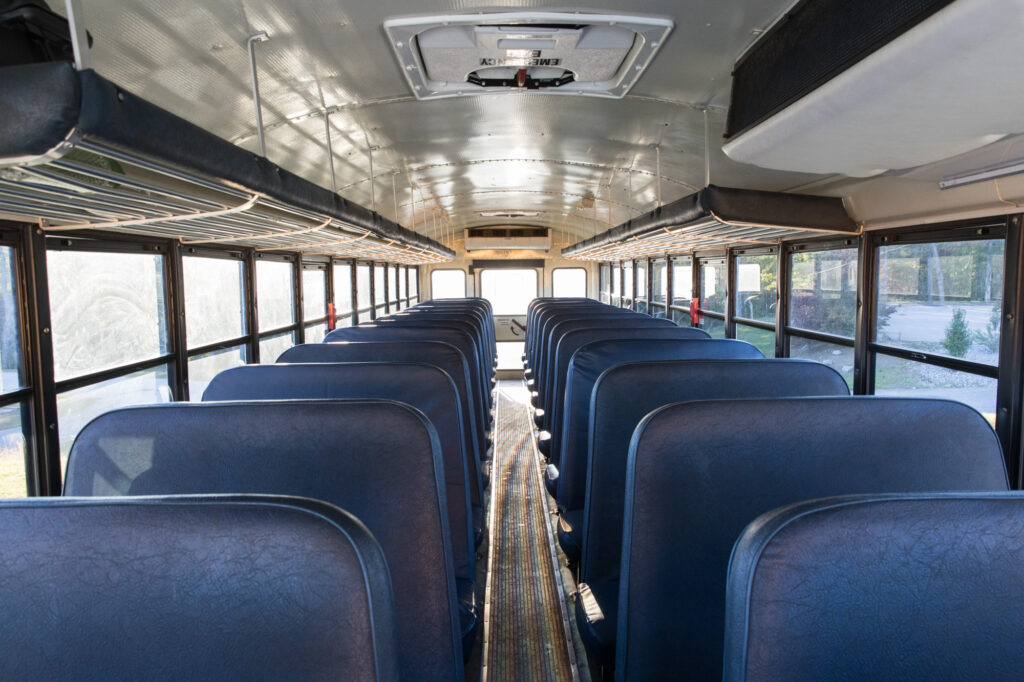“Don’t forget to buckle up!”
This familiar reminder is a staple in driving safety advertisements. Indeed, seat belts are crucial to your safety while on the road. But have you ever wondered why these safety measures aren’t a standard feature in school buses?
Reasons Why School Buses Don’t Have Seat Belts
There are several reasons why you don’t see seat belts on most school buses. Let’s discuss each one in detail.
Seat Belts on Buses Are Not Required By Law

The National Highway Traffic Administration (NHTSA) doesn’t require big school buses (weighing over 10,000 pounds) to have seat belts. Meanwhile, federal law only requires seat belts on light school buses.
It’s up to the state to decide whether to require big school buses to have seat belts.
Some states that require seat belts on school buses include California, Florida, Louisiana, New Jersey, New York, and Texas. Most of these states only require seat belts on new buses.
Buses Have Alternative Safety Measures
So you may be wondering: why doesn’t the NHTSA require seat belts on big school buses? If school buses aren’t equipped with seat belts, doesn’t that lower passenger safety?
Well, the National Safety Council states that school buses are 40 times safer than the average family car.
School buses are specially engineered to be safe. Most school buses feature seats that have high backs and a lot of cushioning. They’re also packed tightly to achieve compartmentalization.
In short, if a school bus gets involved in a collision, the seats would get most of the impact.
It’s Hard to Enforce
Children are full of energy. They seldom sit still for long without direct adult supervision, like in school buses, where the driver is the only adult.
Bus drivers can’t ensure the children are buckled up during the trip because they must focus on the road. So, unless there’s a teacher on the bus, there’s no guarantee the students will use the seat belts.
Seat Belts Can Cause More Harm Than Good
Surprisingly, some experts argue that seat belts on school bus seats can harm children instead of protecting them during a crash.
There’s no guarantee that children will wear their seat belts correctly at all times. For example, if they wear it across their neck or their abdomen, they could sustain serious injuries during a crash.
Also, if a fire breaks out or the bus crashes into the water, the children could get trapped in their seats.
School Buses Travel at Low Speed
School buses usually only travel in a specific area, and the highway is rarely part of their route.
Most school buses pass through local roads with a speed limit of 45 mph. Collisions on these roads can have less impact compared to those on highways.

Seat Belts Will Reduce Bus Capacity
Seats equipped with seat belts occupy more space. So, if school buses were to be equipped with seat belts, they’d accommodate fewer passengers.
The students who can no longer ride the bus would have to find another means of going to school. Unfortunately, other modes of transportation aren’t as safe as school buses for children.
About 800 children die each year while walking, biking, or riding a passenger car to and from school. Meanwhile, less than 10 children die each year in school bus accidents. Studies have also shown that in these deaths, seat belts would not have made any difference.
There’s Not Enough Benefit to Justify the Cost
Experts say that seat belts aren’t necessary in school buses. They have little to no impact in case of a collision. So most states have concluded that it’s simply not economical to require school buses to have seat belts.
The projected expense of installing seat belts on every school bus could exceed $100 million for each state.
School Bus Safety Tips
Safety is a two-way street. Even if a school bus is considered the safest mode of transport to school, you still have to do your part to keep your children safe.
Here are some of the school bus safety tips you and your kids should know:
Go to the Bus Stop at Least Five Minutes Before It Arrives
Arriving early will give your child more time to board the bus without rushing. Also, it will give them ample time to check if they have everything they need for school.
When the bus arrives, make sure you’re at least three giant steps (6 feet) away from the curb. Wait until the bus stops completely and the driver says it’s okay to let your child board the bus.
Flashing Signal Light System
It’s also important to be aware of the signal light system that most school buses use.
Yellow light means that the bus is stopping or preparing to load or unload students. Meanwhile, a red flashing light and an extended stop arm indicate that children are getting on or off the bus.
If Something Falls Under the Bus, Don’t Pick It Up Immediately
If you or your child dropped something and it went under the school bus or anywhere near it, don’t rush to pick it up. Let the driver know first to avoid getting run over.
Utilize the Bus Handrails to Avoid Falls
Remind your child to use the handrails when exiting the bus. Also, tell your child to be careful—especially if they are wearing bags with straps or handles that can get caught in the handrails or doors.
Any information provided on this Website is for informational purposes only and is not intended to replace consultation with a professional mechanic. The accuracy and timeliness of the information may change from the time of publication.


















